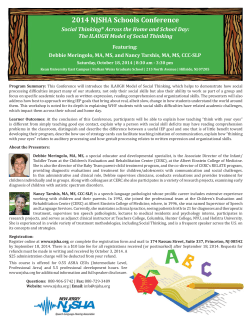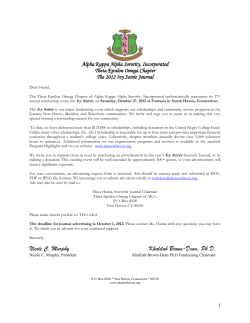
How to EasyDIF Ryuichi Kumagai Tohoku University 2012/06/28
How to EasyDIF 2012/06/28 Ryuichi Kumagai Tohoku University 2011/10/28 1 1. What’s EasyDIF ? EasyDIF is the software for analysis of Differential Item Functioning (DIF). Feature of EasyDIF - “Index K” is used for measuring effectiveness of DIF. “Index K” is original method by Ryuichi Kumagai. - Comparison of two or more populations. - Polytomous Data. - GUI for “Easy” use. Reference Kumagai, R. (2012) A new method for estimating differential item functioning (DIF) for multiple groups and polytomous items: Development of index K and the computer program "EasyDIF". Japanese Journal of Psychology, 83(1), 35-43. (in Japanese) 2011/10/28 2 2.1 Run EasyDIF 2011/10/28 3 2.2 Setting Data File 1. Drag & Drop “Data File”. Data File is “txt format”. See the attached “SampleData.dat”. 2. Input Settings - Column of Response located. (“9” in SampleData) - Character of Omit response. (initial value “P” ) - Number of Groups. (“2” in “SampleData.dat”) - Column of Group Variable. (“7” in “SampleData.dat”) 3. Click “Read Data” button. 2011/10/28 4 2.3 Select Items If you want to change ItemID, Drag & Drop “ItemID File” here. “ItemID File” is text file that recorded one ItemID per one line. (See and rewrite the attached “ItemID.dat”.) 1. Select the items and decide “Non DIF” or “Study”. “Non DIF” item is already known that which doesn't have DIF. “Study” item is that you examine whether "DIF" exist. If you wouldn't like to use, click the column of “USE” (displayed “X”). 2. Click “OK” button. If all items are "Study", they must be treated as "Non DIF". In case of this, check this option. 2011/10/28 5 2.4 Graph window If “Index K” was printed in red , that item has effects of DIF. This button toggles the Expected Score Curve and IRCCC. 2011/10/28 6 3. What’s “Index K” ? “Index K” is calculated using the following procedure. Step 1. Splitting the data matrix. items 1 2 3 4 … N items 1 2 4 … N 3’ 3* Group 1 Omit responses Group 2 Now, Item 3 is “Study item”. Another are “NonDIF items”. 2011/10/28 7 3. What’s “Index K” ? Step 2. Calculating the item parameters. We calculate the item parameters using data matrix in Step 1. - EasyDIF uses Graded Response Model. - Multi group model is adopted. We obtain two sets of item parameters about study item (item 3’ and 3*), and two population distributions (group 1 and 2). 2011/10/28 8 3. What’s “Index K” ? Step 2. Calculating the item parameters. Item Response Category Characteristic Curve about study item. 1.0 PROBAIBILITY 0.8 0.6 0.4 Group1 Group2 0.2 0.0 -4 -2 0 2 0.18 4 THETA 0.16 Group1 0.14 Group2 WEIGHT 0.12 0.10 0.08 0.06 Population Distributions. (Group1 and Group2) 0.04 0.02 0.00 -3.4 2011/10/28 -2.4 -1.4 -0.4 0.6 1.6 2.6 3.6 THETA 9 3. What’s “Index K” ? Step 3. Calculating mixing group distributions. 𝑁1 𝑁2 𝑁 ⋯ 𝑁𝑢𝑚𝑏𝑒𝑟 𝑜𝑓 𝑎𝑙𝑙 𝑒𝑥𝑎𝑚𝑖𝑛𝑒𝑒𝑠 𝑔𝑇 = 𝑔 + 𝑔 𝑁 1 𝑁 2 𝑁1 ⋯ 𝑁𝑢𝑚𝑏𝑒𝑟 𝑜𝑓 𝑒𝑥𝑎𝑚𝑖𝑛𝑒𝑒𝑠 𝑖𝑛 𝑔𝑟𝑜𝑢𝑝1 𝑁2 ⋯ 𝑁𝑢𝑚𝑏𝑒𝑟 𝑜𝑓 𝑒𝑥𝑎𝑚𝑖𝑛𝑒𝑒𝑠 𝑖𝑛 𝑔𝑟𝑜𝑢𝑝2 0.18 0.16 Group1 0.14 Group2 WEIGHT 0.12 Both 0.10 0.08 0.06 0.04 0.02 0.00 -3.4 2011/10/28 -2.4 -1.4 -0.4 0.6 1.6 2.6 3.6 THETA 10 3. What’s “Index K” ? Step 4. Calculating item expected score curve. Cj 1.0 E j Pjc c c 1 PROBAIBILITY 0.8 0.6 0.4 Group1 Group2 0.2 5 0.0 -2 0 2 4 THETA Expected Item Score -4 4 3 2 Gropu1 Group2 1 -4 2011/10/28 -2 0 2 4 THETA 11 3. What’s “Index K” ? Step 5. Calculating index K. ∞ 𝐾= −∞ 𝑄 ≈ 𝑃1 𝜃 − 𝑃2 𝜃 𝑔𝑇 𝜃 𝑑𝜃 𝑃1 𝜃𝑞 − 𝑃2 𝜃𝑞 𝑔𝑇 𝜃𝑞 𝑞=1 Index K is a combination of Thissen’s method (Thissen, Steinberg, & Wainer, 1993) and SIBTEST (Shealy & Stout, 1993). Shealy, R., & Stout, W. (1993). A model-based standardization approach that separates true bias/DIF from group ability differences and detects test bias/DTF as well as item bias/DIF. Psychometrika, 58, 159-194. Thissen, D., Steinberg, L., & Wainer, H. (1993). Detection of differential item functioning using the parameters of item response models. In P. W. Holland & H. Wainer (Ed.), Differential item functioning. Hillsdale, NJ: Lawrence Erlbaum. pp. 67-113. 2011/10/28 12 4. Interpretation of “Index K” If index K is larger than "(Number of categories - 1)*0.1", we assume that DIF is large. (e.g.: in dichotomous item (2-1)*0.1=0.1, and 5 points scale items (5-1)*0.1=0.4 ) In EasyDIF's output file, if index K is larger than "(Number of category - 1)*0.1", it displays "###". ItemID, Item001, Item002, Item024, Item025, 2011/10/28 IndexK, > (#Category-1)*0.1 0.04747 0.06345 0.78765, ### 0.40359, ### 13 4. Interpretation of “Index K” Kumagai(2012) reported that "(Number of category - 1)*0.1" is equivalent to “ΔMH > 1.5". " ΔMH > 1.5" means "large" DIF in ETS research(Roussos & Stout, 1996). Figure : Plots Index K and ΔMH in dichotomous simulation data. (Kumagai, 2012) 2011/10/28 14 4. Interpretation of “Index K” Index K means that average of correct probability (or expected category) differences among groups. It is same definition in Beta estimates in SIBTEST(Shealy & Stout, 1993). Expectation of differences Figure : Item Expected category characteristic curve in Big-Five scale data. (Kumagai, 2012) 2011/10/28 15 Thank you ! Ryuichi Kumagai Graduate School of Education Tohoku University irtanalysis@yb.main.jp 2011/10/28 16
© Copyright 2025





















